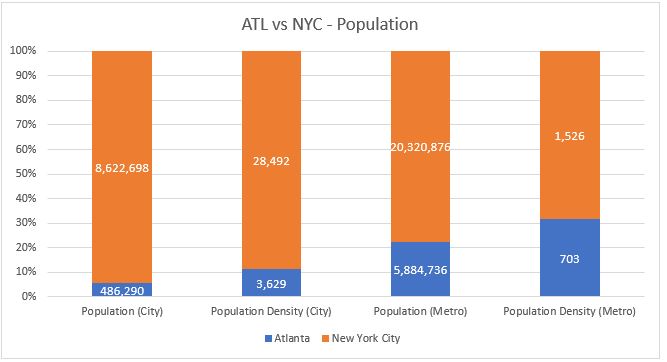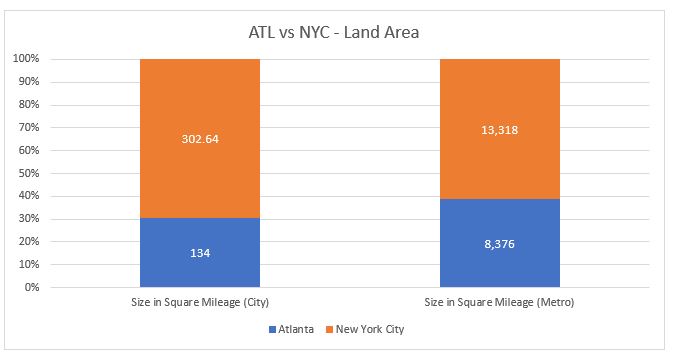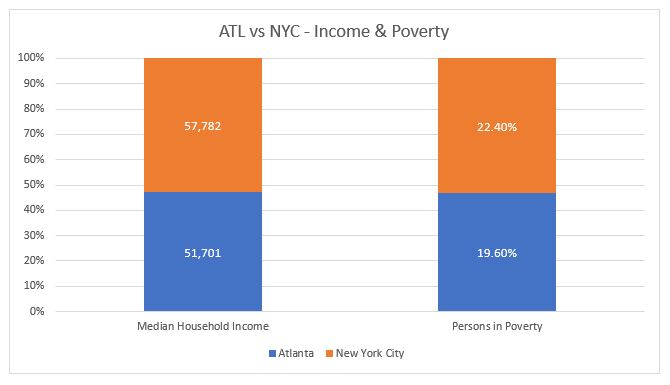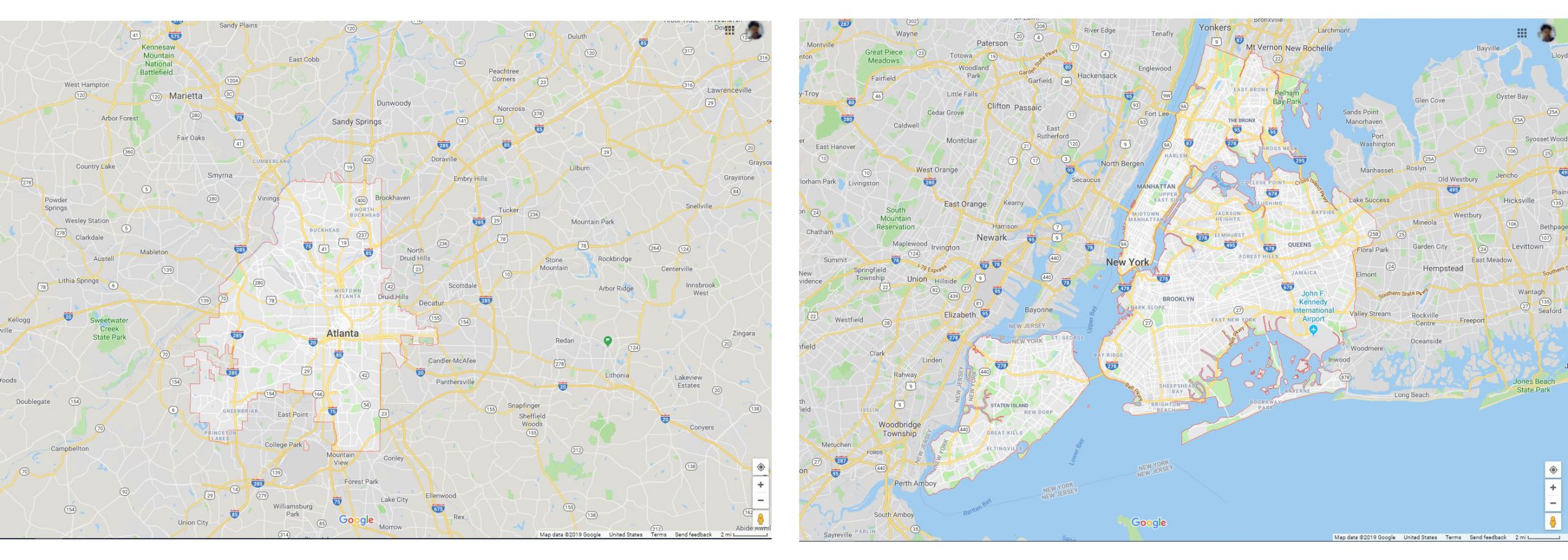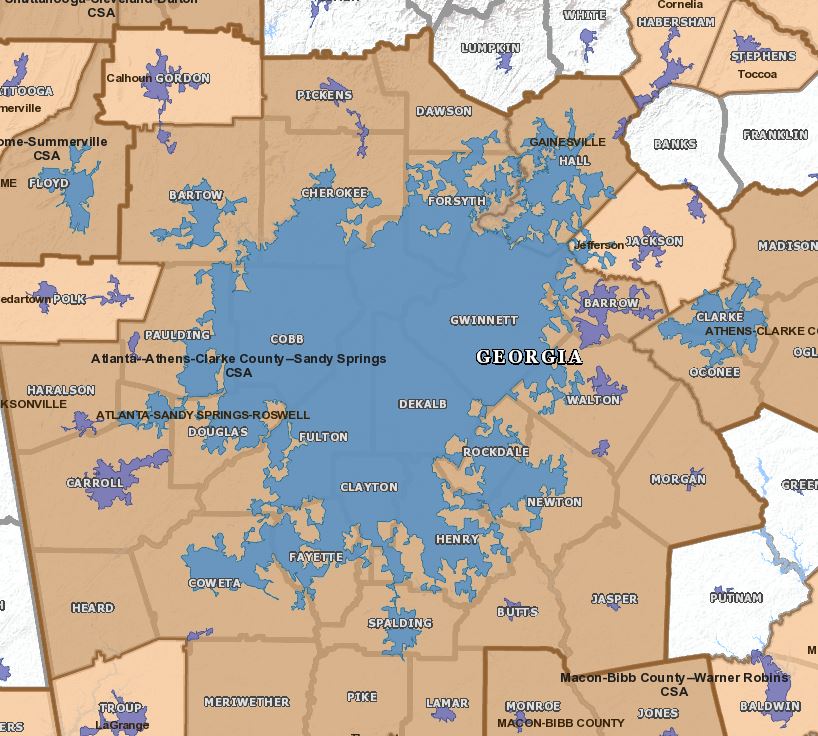How Auto Dealerships Might Address the Way Consumers Get Around in the Future
A Brief History of the Personal Automobile
Although Americans soon dominated the automobile industry starting over a century ago, the automobile was born in France and Germany in the late nineteenth century. Karl Benz, Nicolaus Otto, Gottlieb Daimler, and Emile Levassor refined the automobile, laying the groundwork for the consumer market. Wilhelm Maybach is credited for designing the 1901 Mercedes, the first modern automobile, for Daimler Motoren Gesellschaft.
After Henry Ford’s innovative assembly line production became a standard, the automotive companies saw increased economies of scale in manufacturing and a subsequent rise in middle-class consumer demand. By 1913, the U.S. produced 485,000 of the 606,000 or 80% of the motor vehicles produced worldwide. In the 1920s, Ford, General Motors and Chrysler became known as the ‘Big Three’ automotive companies. By 1925, 75% of all automobiles were bought using credit. This solidified the American economic habit of buying expensive consumer goods on credit and fueling the rapid expansion of the automobile industry. By 1927, Ford stopped making the Model T, after selling 15 million units with a price reduced to $290.
GM innovated the concept of ‘planned obsolescence’ in the 1920s and 1930s. The goal was to ‘encourage’ consumers to trade in their car for a more expensive car by using major design and option updates every three years. The mantra at GM was “the primary objective of the corporation was to make money, not just to make motorcars.” This change in strategy had a direct impact on competition between Chevrolet and Ford, with Chevrolet rising over Ford in the low-priced market, and GM dominating the U.S. market 43%, to Ford’s 22% and Chrysler’s 25%.
After the industry pivoted manufacturing to meet the demands of the military during World War II, production for the consumer market rose after the war to meet the growing worldwide demand. The late ‘40s to the late ‘50s was the golden age of automobile production. During this time, American suburban areas experienced major expansion, fueling the beginning of the sprawling metro areas we live and work in today.
American car companies sold a record 12.87 million units in 1978. But by 1982, American-made car sales had dropped to 6.95 million, owing to imports increasing their market share from 17.7% to 27.9%. Japan became the world’s leading auto manufacturer in 1980, a position it holds in 2019. By 1980, over 87% of American households owned at least one automobile and 51.5% percent of households owned more than one. While most Americans own a car, which has been a standard in the American Dream dynamic, getting around and mindsets behind car ownership are slowly changing. There are some who think the age of personal automobile ownership is in the beginning stages of the end.
The Beginning of the End of Personal Automobile Ownership
Automobile sales have only increased by about 3.3 million or 23.6% or .087% each year between 1990 and 2017. This is against an increase of 67 million people of car-buying age (35% increase or 1.3% each year during the same period. The car-buying age population growth rate was about 15 times that of the car sales growth rate. In fact, the former VP of GM said “We are approaching the end of the automotive era”.
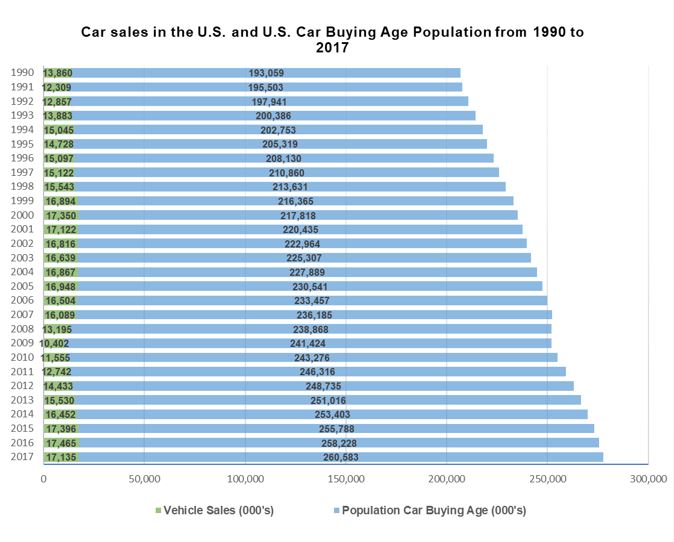
Car-Sharing/Ride-Sharing Platforms
In 2000, two Boston women Antje Danielson and Robin Chase started Zipcar, a car-sharing service. The service allows short term car rentals. It was easy to use and for the user that only needed a vehicle for a couple of hours, the cost was between $7-$12 per hour and with no requirements to have insurance or refueling when returning the car. Car-sharing didn’t start with Zipcar. You’d have to go back to 1948 in Zurich Switzerland when a housing co-op offered a car-sharing service for its tenants. In the ‘70s and ‘80s, large-scale car-sharing operations operated in Switzerland and Germany. StattAuto, a German car-sharing service was successful and made the path to opening a similar service easier in the U.S. Carshare Portland was the first car-sharing service in the U.S.
The car-sharing model saw successes in major American cities, with many operators coming in to follow the trend from U-Haul, Hertz, Avis, and Enterprise among them. By late 2012, Zipcar had 80% of the U.S. car-sharing market and half of the worldwide market with 730,000 members sharing 11,000 vehicles. By 2020, worldwide car-sharing revenue is expected to rise to $6.2 billion and 12 million members according to Navigant Consulting. This expansion is fueled mostly by generational mindsets about car ownership and increasing costs to own a personal vehicle.
Although ridesharing goes as far back to 1605 with the launch of a horse-drawn carriage taxicab service, most people associate modern ridesharing with the arrival of Uber in 2010 and Lyft in 2012. These smartphone-enabled platforms have revolutionized the car service industry and overall have negatively affected taxicabs’ bottom lines. These platforms offer a few benefits such as more efficient ride-ordering and cheaper service. For example, one five-city study found that Uber drivers utilized their vehicles at higher capacity rates than taxicabs. This is mostly due to its larger reach, more efficient ordering and pricing methods and the platform doesn’t have to wrestle with taxicab regulation inefficiency.
E-scooters and e-bikes can be thrown in the mix of transportation options for American cities. They are most helpful in providing ‘last-mile’ connectivity for transit users that still have a significant distance to walk after getting off a train or bus. Uber and Lyft are most likely the number one reason that driving-age teenagers are opting not to get their driving license.
Ridesharing User Sentiment on Buying a Car – Source: Statista
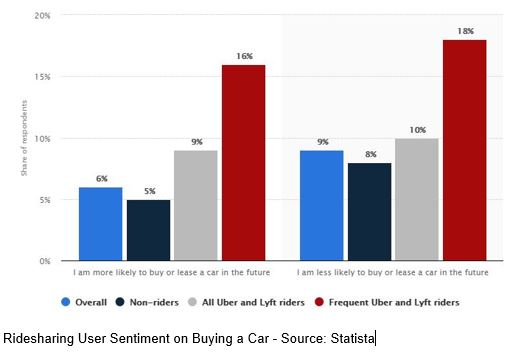
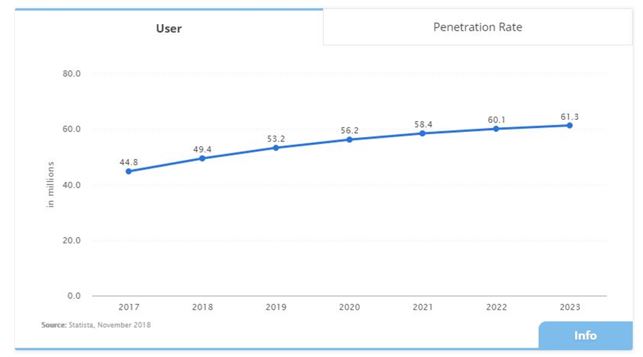
Ridesharing Usage & Projections 2017-2023 – Source: Statista, Nov. 2018
Some car manufacturers are offering car subscription services in a bid to address millennials’ and gen z’s embrace of subscription services such as Spotify, Ipsy and Blue Apron. This is similar to what happened with the music recording industry. Twenty years ago, consumers owned music on cassette tapes, vinyl, and CDs. This model was disrupted in a relatively short time as music media went from the physical to the cloud. Consumers didn’t take long to adjust to this new way because as long as they were able to listen to their favorite songs, it became less important how they did it. While car subscription services are too new and tend to be on the pricier side of transportation options now, this will undoubtedly change as price points decrease as they scale up users.
What’s the Future of Getting Around?
The one question that has remained constant during the past 200+ years is ‘how will I get from point A-Z?’ Transportation, like music a decade ago is becoming less about owning the vehicle than just getting around no matter how. Early automobiles were sold directly to the consumer or through several channels such as department stores, direct mail or traveling salespeople. The franchise dealership became the almost exclusive way to sell new cars in the U.S. This system requires that dealers accept a quota of cars specified by the manufacturer, must pay cash on delivery, maintain service facilities as approved by the manufacturer and only sell only a certain new car make.
The dealer is guaranteed sales territory and may receive manufacturer financing or advertising assistance in return. Dealerships haven’t been consistently happy throughout the dealer-manufacturer relationship and have complained to their respective state legislative bodies throughout. This culminated in legislation and a federal statute in 1956 to protect dealerships from arbitrary actions by car manufacturers. Automakers tried to return to the early days of direct selling to the consumer in the 1990s when the internet became consumer-friendly with the advent of the World Wide Web. American automobile dealerships lobbied state governments to block this practice and subsequently prohibit manufacturers from owning dealers through subsidiaries. Car manufacturers can sell directly to consumers in Europe and South America via the internet in limited quantities.
Automobile dealerships are at a point where auto selling is slowly transforming into the business of transportation or transportation ownership type consulting. In a world where millennials and gen z consumers are sharing, streaming and renting, ownership as a major goal in service and product attainment will most likely see decreasing consumer attainment behaviors. This puts the auto dealership in a great position to be at the forefront of this inevitable consumer habit change. Automobile dealerships already have the physical and virtual infrastructure to transform into a transportation consultant business model.
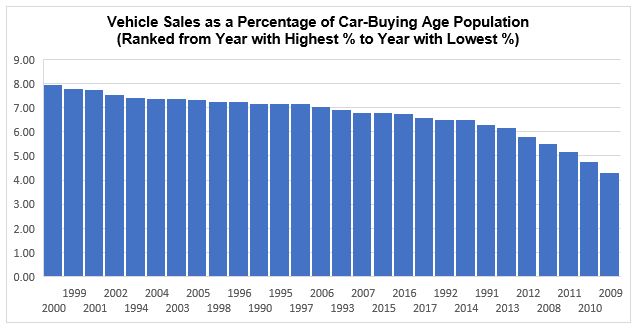
How Does the Transportation Consultant Business Model Work?
A transportation consultant is merely a former automobile dealer (which only sells or leases new and used vehicles) which is transformed into a place where a consumer is provided with more options of how to get from point Y-Z. This business model can offer to include slow-selling models as part of their own car subscription service. They can offer car-sharing services. They can even offer discounted rates to ride-sharing drivers along with special buying, leasing or car-sharing rates to the riders of the ride-sharing drivers that received the discounted rates. In this future, the transportation consultant would not be bound by manufacturing brands but would become much like transportation ‘department stores’ offering transportation services and options.
They could even offer a grand subscription service that partners with ride and car-sharing, a car subscription service, into one service which offers full seamless transportation options. For instance, a consumer can sign up for a service costing $800 a month. Within this service, the consumer can use a certain vehicle for 100 hours each month, use Uber or Lyft. Basic service and insurance would be included. As the month progress, an app would subtract the amount used from the user’s account based on the method of transportation. The consumer would always know how much transportation dollars they have left.
Arbitrary numbers were used, so if this futuristic transportation consultant scenario were to become a reality, the financials would have to be worked out to meet the needs of both consumer and transportation consultants in a balanced way while considering marketability and profitability. The whole dealership way of doing business would have to be changed at the state level to allow for this new way to offer transportation services.
Sources:
OVERVIEW: THE CARSHARING TREND
The Ridesharing Revolution: Economic Survey and Synthesis-Brookings Institute

